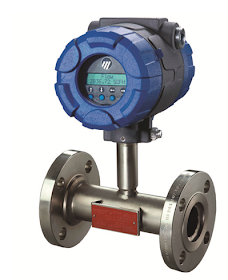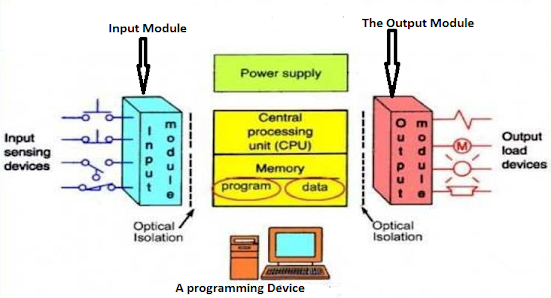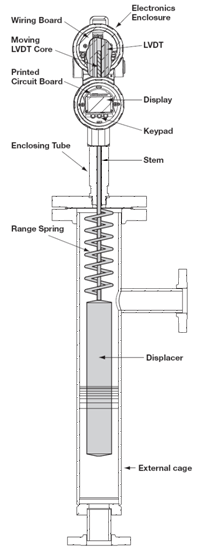Thermal mass flowmeters work on the principle that
when you place a heated object in the midst of a fluid flow stream and measure
how much heat the fluid transfers away from the heated object, then you can be able
to determine the mass flow rate. Industrial thermal mass flowmeters consists of
a specially designed flow tube with two temperature sensors inside: One that is
heated and one that is unheated. The heated sensor acts as the mass flow sensor
(cooling down as flow rate increases) while the unheated sensor serves to
compensate for the “ambient” temperature of the process fluid. The
following diagram shows an example of a thermal mass flowmeter from Magnetrol.
 |
| Magnetrol Thermal Flowmeter |
An important factor in the calibration of a thermal
mass flowmeter is the specific heat of the process fluid. Fluid with high
specific heat values make good coolants because they are able to remove much
heat energy from hot objects without experiencing great increases in
temperature. Since thermal mass flowmeters work on the principle of convective
cooling, this means a fluid having a high specific heat value will elicit a
greater response from thermal mass flowmeter than exact same mass flow rate of
a fluid having a lesser specific heat value. Therefore it is paramount that you
know the specific heat value of the fluid you plan to measure with a thermal
mass flowmeter and be assured that its specific heat value will remain
constant. For this reason, thermal mass flowmeters are not suitable for
measuring the flow rates of fluid streams whose chemical composition is likely
to change over time.
Another potential limitation of thermal flowmeters
is the sensitivity of some designs to changes in flow regime. Since the measurement
principle is based on heat transfer by fluid convection, any factor influencing
the convective heat-transfer efficiency will translate into a perceived
difference in mass flow rate. Turbulent flows are more efficient at heat
convection than laminar flows. Therefore, a change in flow regime from
turbulent to laminar will cause a calibration shift for this design of thermal
mass flowmeters.
So what are some of the applications where thermal flowmeters are used?
Generally thermal flowmeters are used in
applications where the composition of the fluid is known especially in purified
gases. Having said that, lets look at some of the areas where thermal
flowmeters are commonly used:
Natural Gas
Flow measurement of natural gas fuel usage is important for
combustion efficiency as well as general energy management projects for both
industrial and commercial facilities. Thermal mass flowmeters will monitor the
flow to individual combustion sources.
Air Efficiency
In combustion applications, thermal mass flow
meters can ensure repeatability of air flow measurements to obtain an efficient
air-to-fuel ratio. On compressed air, it is common to measure for plant
allocation or to determine leaks.
Tank Blanketing
Nitrogen is frequently used to maintain an inert
environment in the vapor space of a tank. Thermal meters are ideally suited for
measuring the flow of nitrogen in such applications because they support mass
measurement, they are easily installed into the pipe & are excellent at
measuring low flow rates.
You can also read:
Flare & Vent Gas
Thermal mass meters are a particularly good fit for
flare measurement. Flares can range from vent gases at atmospheric pressure to
high flow applications needing extended turn down. Oil and Gas is a common
industry here.
Follow this blog for updates on instrumentation articles or
subscribe here.
Biogas
Both the landfills and anaerobic digesters at
wastewater plants produce a mixture primarily composed of methane and carbon
dioxide. Excellent low flow sensitivity, hot tap capabilities and mixed gas
calibration make thermal mass flow measurement a popular technology.
Source: Magnetrol








